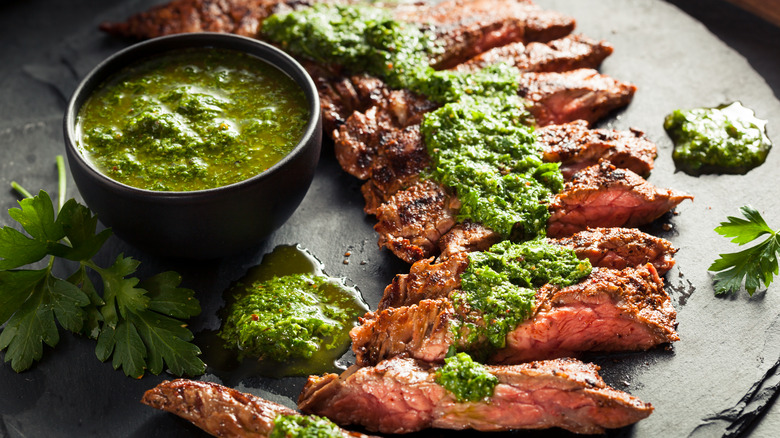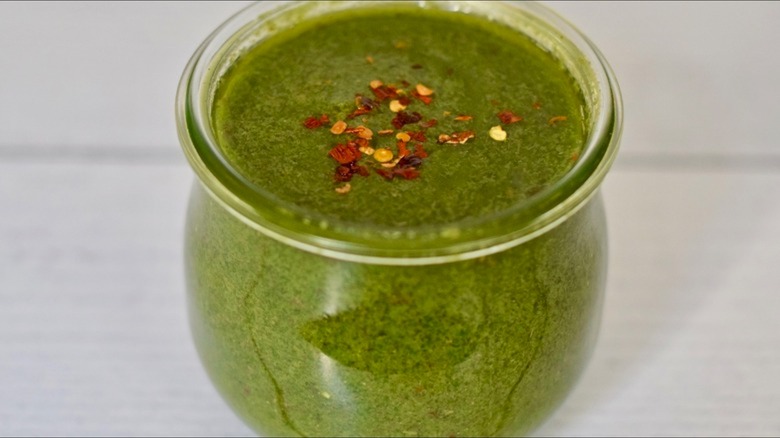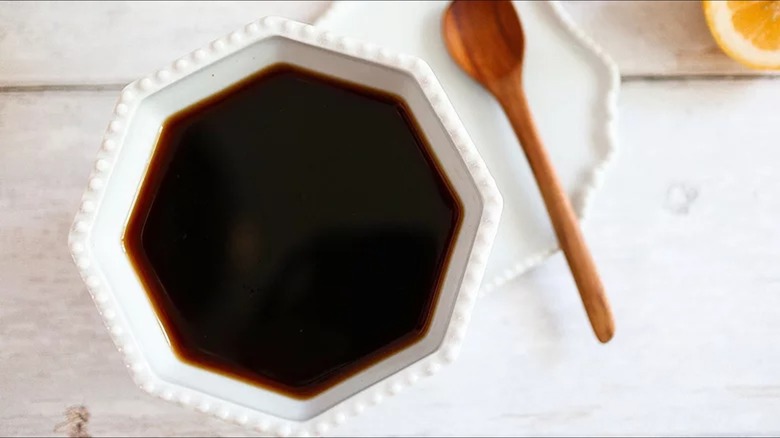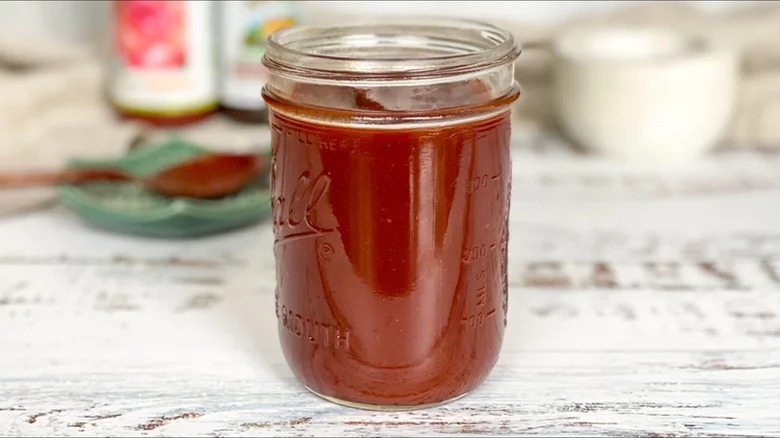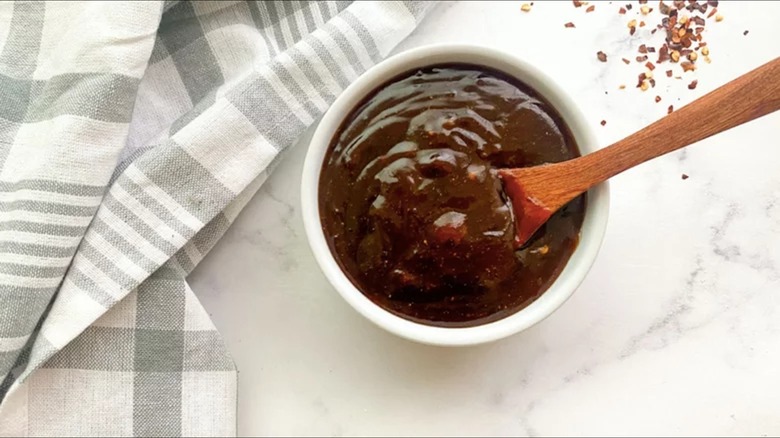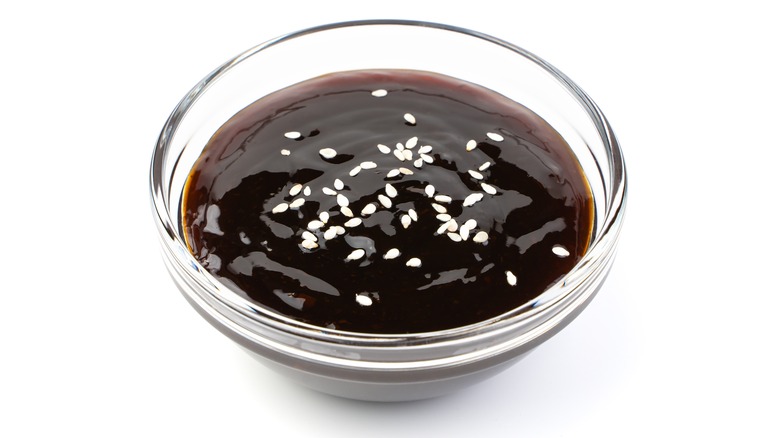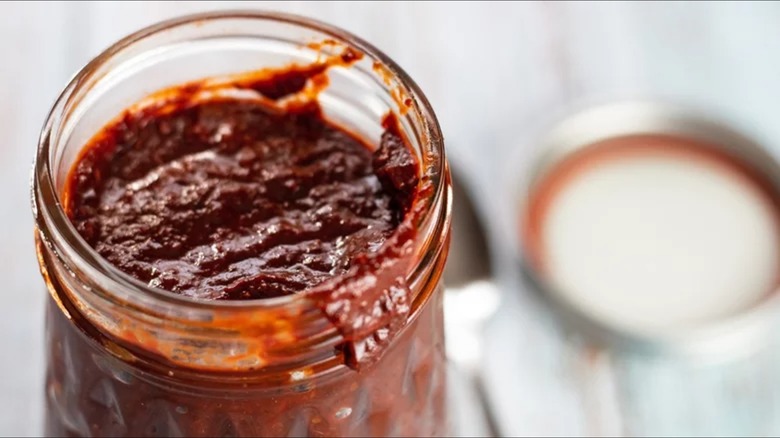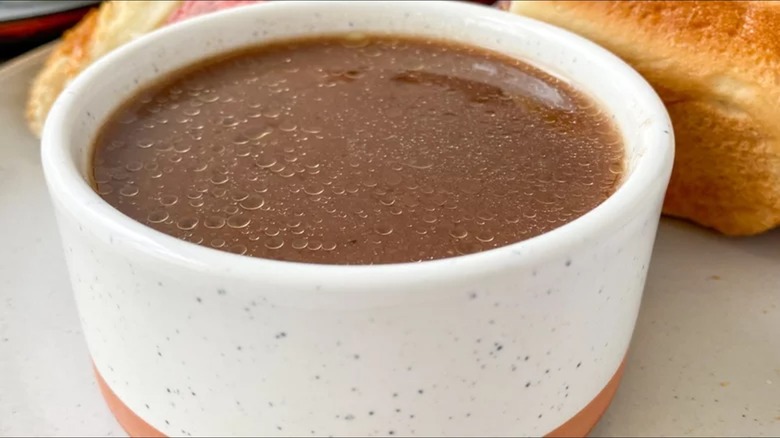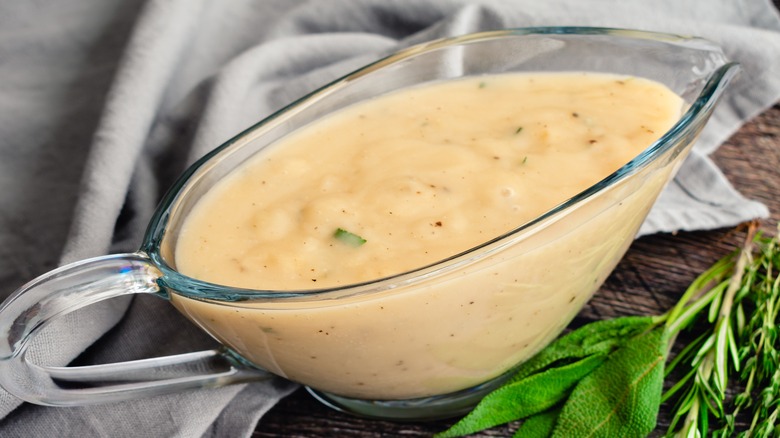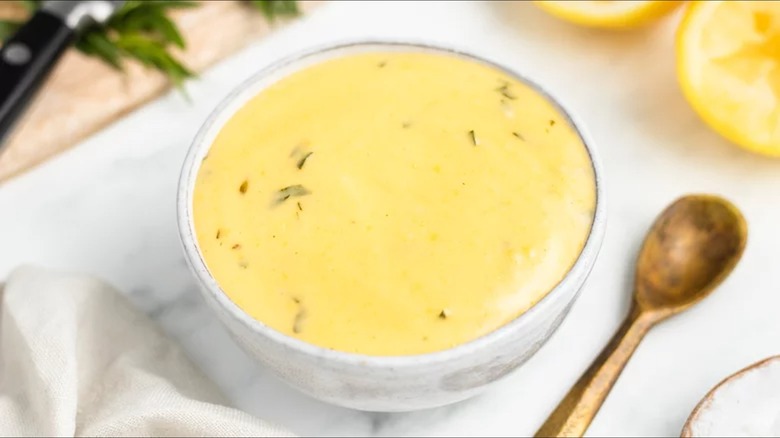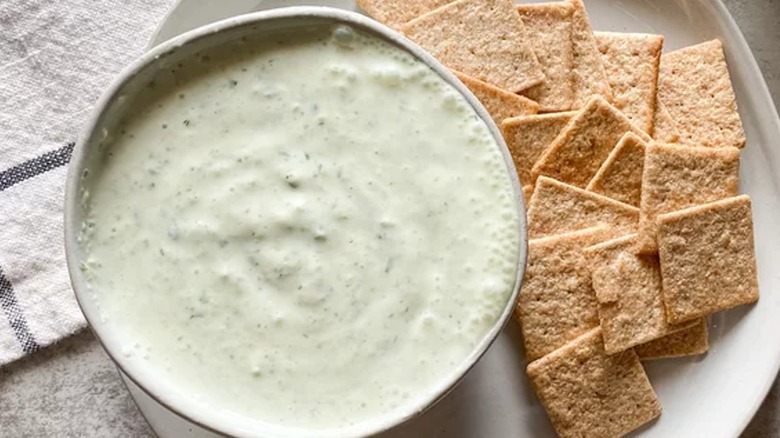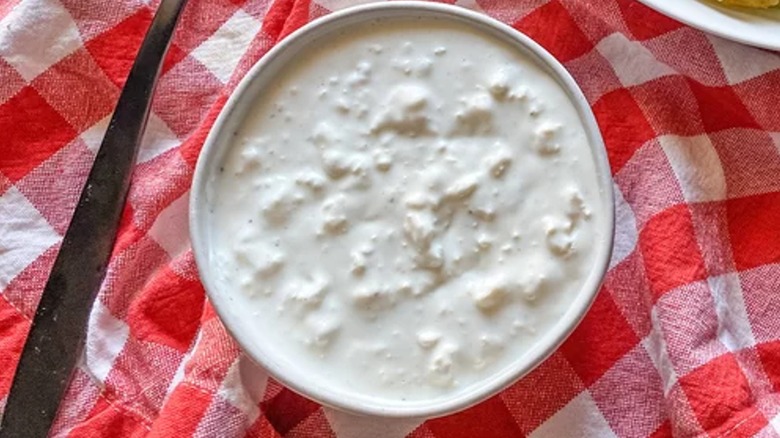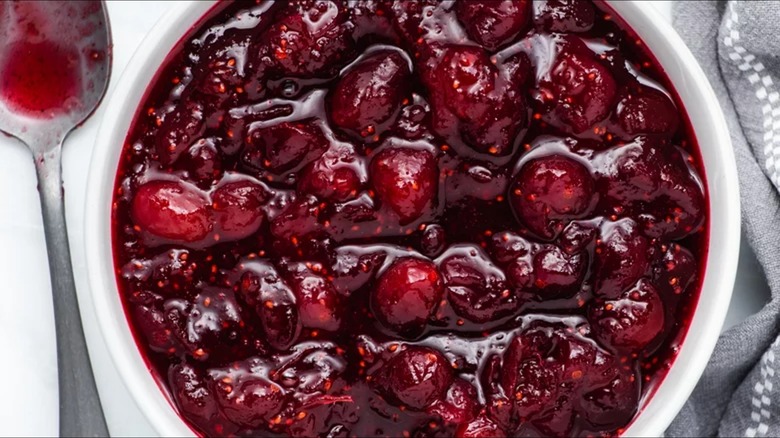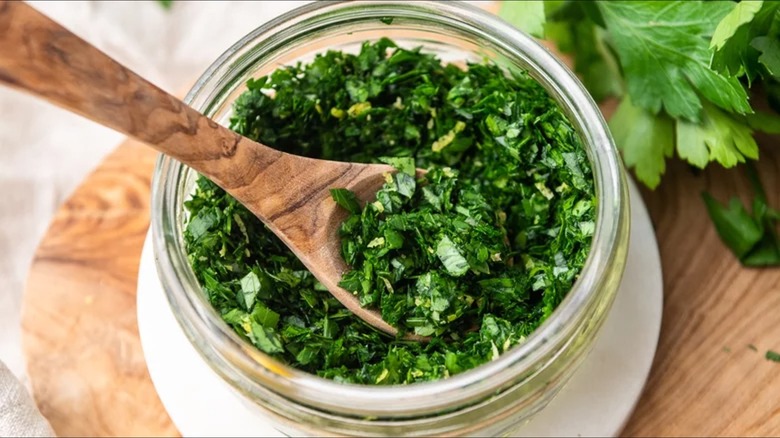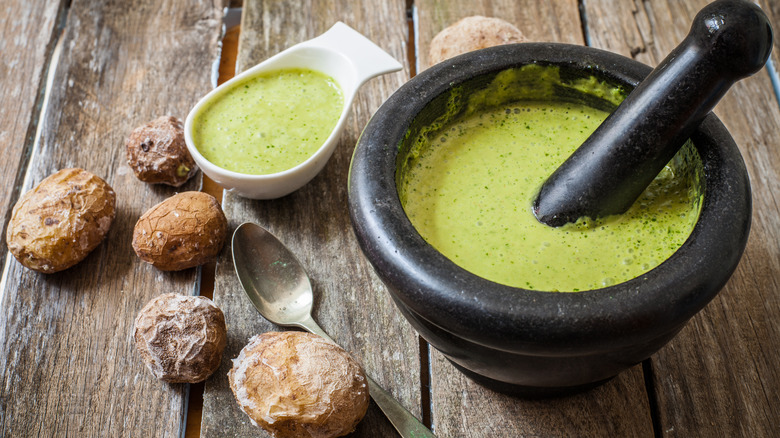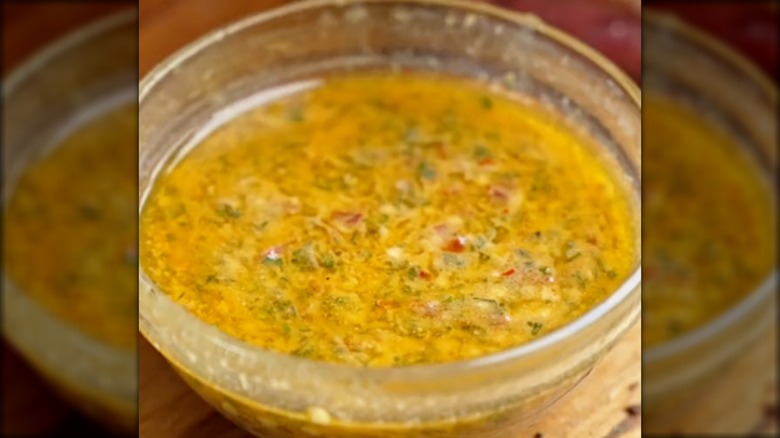The Best Non-Steak Sauces For Your Favorite Cut Of Meat
If you're only using steak sauce to top your favorite cut of meat, you're missing out on a world of non-steak sauce. The right sauce can bring new life to the experience of eating the same meats day after day. Plus, having an arsenal of sauces at your disposal can help you branch out to try new meat cuts and cooking styles, as well.
We've compiled a list of sauces that vary to fit different tastes and moods. If you're looking for sauces with international flair, you might try Korean BBQ, teriyaki, ponzu, or tzatziki sauces. In another vein, gravy and au jus are classic comfort sauces. However, if you're looking for something fresh and green, you might try herbaceous sauces like gremolata, chimichurri, or mojo verde. The sauces on our list pair with a variety of meats, so get ready to send your taste buds on a flavor adventure no matter what cut you cook next.
Chimichurri
Chimichurri is a fantastic sauce for adding a fresh burst of lip-smacking, acidic flavor to your meat. There's not a clear origin story for chimichurri, but it was likely invented by roaming South American gauchos (cowboys) in the 1800s. The invention likely happened in what is now Argentina, Uruguay, and Paraguay. You can't find recipes for this sauce until its inclusion in cookbooks from the late 1950s, so there's no clear historical trail to follow.
The recipe for this sauce varies across South America, but it always starts with fresh green herbs like parsley, cilantro, or mint. It tends to also contain oil, vinegar (and maybe another acid like lemon juice), salt, and spices. You'll find chimichurri recipes that use spices like oregano, cumin, black pepper, and red pepper. We like it best with cilantro and lots of garlic.
While it was likely first used on beef, we can't think of any type of meat that chimichurri wouldn't complement. It's commonly served on churrasco (grilled beef) in South America. However, you can add it to your favorite cut of steak, grilled sausages, chicken, pork, seafood, or any other type of meat. We've even used it as a hamburger condiment. Once you taste it, you'll probably dream up new ways to use it.
Ponzu sauce
Ponzu sauce adds a touch of tangy citrus and umami-rich flavors to meat. The name of the sauce combines the Dutch word for "punch" with the Japanese word for "vinegar," making it "punch vinegar." It's a purely Japanese sauce, so the Dutch in the name likely comes from the Japanese borrowing words from the Dutch when the Dutch East India Company was trading with Japan between the early 1600s and mid 1800s.
Ponzu sauce contains rich ingredients like soy sauce, mirin (rice wine), kombu (seaweed), bonito flakes (smoked and fermented tuna), and citrus juice. You can use citrus fruits like lemon as your source. However, if you have some ponzu in Japan, it may also use other citrus fruits like yuzu or sudachi.
Ponzu works as a marinade because of its acidity. However, its richness makes it a nice dipping sauce for beef shabu-shabu (Japanese hot pot), which is beef cooked with the Japanese tataki cooking style, or simply for thinly sliced beef. It's also delicious on chicken and pork.
Barbecue sauce
Barbecue sauce provides a delicious way to add sweet and tangy flavors and sometimes smokiness to your favorite meats. The inspiration for what has become barbecue sauce likely came to America with enslaved people from Africa, evolving to be a vinegar-based sauce as a response to a lack of lemons and limes in the U.S. South. The sauce eventually acquired its characteristic tomatoes in the 1800s and 1900s.
Every region, restaurant, and home cook has a different idea of what makes the perfect barbecue sauce. You'll find ingredients in it like tomatoes (often in the form of ketchup), vinegar, brown sugar, mustard powder, garlic, and sometimes peppers for heat. Sometimes, a smoky ingredient helps give meat the illusion of being smoked or grilled without having to do the work of smoking or grilling.
Barbecue sauce tastes good on a variety of grilled meats that range from chicken and pulled pork to ribs and beef brisket. It also makes a great dipping sauce for everything from chicken tenders to chicken wings. It's also not uncommon to find it as a hamburger condiment.
Korean BBQ sauce
Korean BBQ sauce is fantastic for infusing meat with bold umami and sweet flavors. The predecessor of Korean BBQ, a type of grilled and marinated kebab called maekjeok, dates back nearly 2,000 years. This dish paved the way for the first Korean BBQ restaurants to start popping up and serving both commoners and nobles during the Joseon dynasty (1392–1897).
Joseonok, the oldest restaurant serving Korean BBQ in Seoul, South Korea, uses soy sauce, sesame seed oil, and garlic as its savory sauce components and sugar for sweetness. So, it's a fairly simple sauce. However, we prefer Korean BBQ sauce with a little more flavor variety and additional ingredients like ginger, rice vinegar, and hot sauce.
Korean BBQ sauce is traditionally served with grilled meat. You can use it as a marinade or dipping sauce, so it's versatile. Popular options include pork belly, beef, short ribs, chicken, thinly sliced brisket, and flank steak. You can even use it for more untraditional meats like ostrich if you can find them.
Teriyaki sauce
Teriyaki is a Japanese sauce that provides sweet and savory flavors for meat, leaning more toward the sweet side. Teriyaki has likely been around since the 1600s but it didn't reach the U.S. and evolve until the 1960s.
The base of traditional teriyaki sauce contains soy sauce, sugar, and Japanese alcohol like mirin or sake. The most basic variety might also contain ginger, but it has acquired many variations in the U.S. Sometimes, bottled versions tend to be more like Korean BBQ sauce than traditional teriyaki sauce,
The word "teriyaki" calls to mind the sauce's glossy shine (its "teri") and its grilling or broiling cooking method ("yaki"). However, you're not limited to these meat cooking methods since it also works just fine with pan-fried or roasted meats as a marinade, cooking liquid, or finishing sauce. The sauce is popular for flavoring chicken, beef, and pork. It's a good choice for cuts of beef like flank steak and sirloin steak and is great for stir-fries, kebabs, or as a burger sauce. You can even use it on seafood.
Mole sauce
Mole sauce is a rich, Mexican sauce that simmers for hours or days on the back of stovetops before boosting the umami flavors in various meats. The word comes from the Nahuatl word for sauce ("molli") and varies among regions and families in Mexico. The earliest story of the sauce says it came out of a Dominican convent in Santa Rosa as a special dish for a visiting VIP. Either Sor Andrea made it from every ingredient in the convent's kitchen, or her assistant improved upon Andrea's family recipe because Andrea was sick.
The ingredient list for authentic mole sauce may be as long as your arm and can include onions, different types of dried chile peppers, tomato paste, dried fruits, nuts or seeds, Mexican dark chocolate, and spices like cumin, oregano, cloves, and cinnamon. So, you could end up with a sweeter, more savory, or spicier sauce, depending on who's making it.
Mole sauce is excellent served over chicken, pork, or beef. You can even spoon it over seafood. More than just meat, it's also amazing as a sauce to top Mexican meat dishes like burritos, enchiladas, or nachos.
Au jus
Au jus is a rich, minimalist sauce made from the juices that escape meat during the cooking process. While serving meat with its own sauce is timeless, creating a specific sauce from meat juices likely had its start in the Middle Ages. In French, the word means "with juice." but it's perfectly fine to say "beef with au jus," despite doubling up the use of the word "with."
You can create the au jus by deglazing a meat cooking dish with water, cooking wine, or vinegar and removing the fats and solids. It's good either thin or as a reduction. Some cooks add fresh herbs or other seasonings to enhance the sauce or add a thickener to the sauce, but its traditional flavor and texture come from rich, natural meat juices.
The most common meat to serve with au jus is roast beef. You can pour the sauce back over the beef to make it even more moist and flavorful or use it for dipping your meat. It's most famous as a dipping sauce for French dip sandwiches. However, you can also serve it with other meats, such as prime rib, steak, pork, and even lamb.
Gravy
Gravy is a comforting sauce that both enhances flavor and adds moisture to meat. The Middle English word "gravé" appears in medieval French cookbooks to mean meat juices from roasted meats. Thus, the original version was essentially au jus. It didn't start to contain a roux of fat and flour to resemble today's gravy until the 1800s in England and the U.S.
Gravy starts with a mix of fatty pan drippings or another type of fat and starchy flour (called a roux) and uses broth or other liquids to become a sauce. It may include spices and even solid pieces like mushrooms or meat. Gravy is popular over many variations of meat. You can serve it on the side with chicken tenders or pour it over roasted meat. It adds extra flavor and creaminess to cuts ranging from chicken and turkey to pork and beef, either alone or in open-faced sandwiches. It also doubles as a sauce for side dishes like mashed potatoes.
Pan sauces
Chefs often use what's left in a pan after cooking meat as the basis for a savory sauce. It's an elevated and more gourmet take on gravy, more likely to show up atop meat in a fancy restaurant than in a mom-and-pop diner.
Pan sauces are a cross between au jus and gravy. They start with the juices and caramelized pieces of meat left in a pan. As with au jus, you should remove most of the fat before adding any aromatics (like garlic and shallots). Once the introduced ingredients are cooked through, you can deglaze the pan with liquids such as wine and broth. The sauce is sometimes thickened through simmering and the addition of a thickening agent (this can sometimes be butter added at the end). You might also add extras like Dijon mustard, fresh herbs, spices, or citrus zest depending on the flavor you're wanting.
Pan sauce starts with meat leavings and ends as a topping for meat. So, you can use any meat you cook in a pan as the starter for pan sauce as long as there are some bits left behind. You can make pan sauce with the leavings from steak, chicken, pork chops, lamb chops, duck breast, and other pan-cooked meats.
Béarnaise sauce
Béarnaise is a classic, velvety, tarragon-flavored French sauce that can immediately elevate any meat from ordinary to extraordinary. Chef Jean-Louis Françoise-Collinet created the first Béarnaise sauce in 1836 and served it on meat for the opening day of the Le Pavillon Henri IV restaurant in Béarn, France.
It's a take on Hollandaise sauce, also containing egg yolks, lemon juice, Dijon mustard, butter, and pepper. Béarnaise sauce gets its distinctive flavor from the addition of chopped shallot, white wine vinegar, and fresh tarragon. Some also include chervil, as well. In case you're not familiar with these herbs, tarragon has a mild, licorice-adjacent flavor and chervil is like an aromatic cross between parsley and tarragon.
The anise flavor of herbs and the savory flavor of shallots go well with steak, roast beef, and even hamburger. However, the flavor profile is still light enough to work well with chicken or seafood. You'll also probably want to dip your vegetables into it.
Tzatziki sauce
Using tzatziki sauce with meat takes it to another flavor level with its tangy, garlicky, and fresh ingredients. Some people theorize that this sauce traveled from India or Turkey through traders who brought the idea for Indian raita sauces or Turkish cacik to Greece. All of these sauces contain yogurt, cucumber, and other ingredients like spices or herbs.
Tzatziki sauce specifically uses shredded cucumber, raw garlic, yogurt, herbs like mint or dill, and lemon juice. It's smooth and full of zing and garlicky, herby goodness.
Tzatziki sauce makes an excellent accompaniment to gyro meat of any variety. It's also a tasty hamburger addition, chicken marinade, or topping for roast chicken, shawarma, and fish. You'll also enjoy it as a dipping sauce for kebabs or meatballs. Even if you start with a highly flavored meat like gyro meat, the strong-flavored ingredients of this sauce only drive the intensity of the dish higher and create a taste amalgam you're sure to crave later.
Blue cheese sauce
Blue cheese sauce adds a rich, tangy, and earthy quality to meat dishes. The first blue cheese likely developed in France after regular cheese became contaminated with mold spores from rye flour or rye bread. So, yes, it's moldy cheese, but it's tasty moldy cheese that goes well with meat. However, you don't have to limit yourself to just eating cold cuts alongside blue cheese on a charcuterie platter. Instead, turn your blue cheese into a meat sauce.
Blue cheese sauce starts with pan juices and comes together with butter, heavy cream, blue cheese crumbles, pepper, and aromatics like onions, chives, or garlic. Some cooks also add Worcestershire sauce and chopped parsley. Any light-colored blue cheese makes a good choice for this sauce. Blue cheese sauce pairs nicely with roast beef, hamburgers, and your favorite steak cuts. But, don't sleep on trying it with chicken or pork. You might even want to experiment with buffalo chicken and blue cheese sauce since the flavors go so well on wings.
Fruit sauces
Fruit and meat go together to create a culinary marriage of sweet, savory, and sometimes tangy flavors. While you've likely tasted fruit and meat pairings before, we tend to forget fruit when we're making a sauce for our meat. If you find yourself with an overabundance of fruit, we suggest looking for sauces you can make from it that pair well with your favorite types of meat.
Fruit sauces from citrus are tangy, dried fruits add depth, and berries add sweetness. Any type of meat — ranging from poultry, pork, lamb, and beef to game meat like venison and rabbit — can shine with the right fruit sauce. For example, you'll want to try chicken with lemon, apricot, or cranberry-orange sauce. Duck tastes good with orange sauce, cherry sauce, or plum sauce. Pork pairs well with apples, cherries, or pineapple. You can even eat steak with blueberry or fig sauce. These examples showcase just a portion of fruit sauces' versatility.
Gremolata
If you're looking for a way to make your meat taste fresh and zesty, gremolata is a likely answer. Nobody's sure exactly where gremolata came from or how long it's been around, but it seems to be an Italian invention. Its sharp, fresh flavors provide an uplifting contrast to rich, slow-cooked meats.
Gremolata is a pulverized mixture of parsley, garlic, and lots of lemon zest. There are some regional variations, like the addition of capers and anchovies or pine nuts and Parmigiana Reggiano. If you don't have lemon zest, you can make persillade instead of gremolata, since it only calls for parsley and garlic.
In Italy, you'll find gremolata most often atop slow-braised osso buco (beef shank). However, Italians don't limit gremolata to osso buco, and neither should you. It's perfect with other braised meats like short ribs and pot roast. It's also great on grilled meat. Don't just try it with beef, though; add it on top of chicken, pork, lamb, and seafood, too.
Mojo verde (green mojo)
The Canary Islands of Spain created another fresh green sauce called mojo verde (green mojo). These Islands have several mojos in their sauce arsenal. This version of green sauce was likely inspired by another green sauce that entered the country with the Romans, originating somewhere like Portugal or Italy. However, with the Islands being a hot spot for trading ingredients from all over the world, it eventually became possible to create variations with peppers and foreign spices. The sauce has spread (and evolved) with diasporas throughout the Spanish-speaking world.
The most basic mojo verde contains pulverized cilantro, garlic, lime juice, cumin, black pepper, and extra virgin olive oil. Some versions contain various heat levels of green peppers, as well. Mojo verde is amazing on grilled meats and seafood of all kinds. It makes a flavorful addition to roast pork, beef, and lamb. You can even use it as a meat marinade. We won't fault you if you decide you suddenly want to drizzle mojo verde over everything all year long.
Cowboy butter
If you're looking for an alternative to steak sauce to add to your favorite meat, cowboy butter is a great option. It has a lot in common with classic French beurre composé ("compound butter," butter plus herbs and sometimes lemon juice). Nobody has stepped up to claim cowboy butter as their invention, so we're not sure where it originated. It doesn't matter when it makes meat taste as good as it does.
Cowboy butter contains lots of butter, lemon juice and zest, minced garlic, Dijon mustard, and spices. You can add lots of fresh herbs like parsley, chives, and thyme along with spices such as paprika, cayenne pepper, chili flakes, and pepper. Like compound butter, cowboy butter is excellent added to the top of steak before or after grilling. You won't want to stop there with your cowboy butter experimentation — you'll want to try it with roasted chicken and grilled shrimp, as well.
